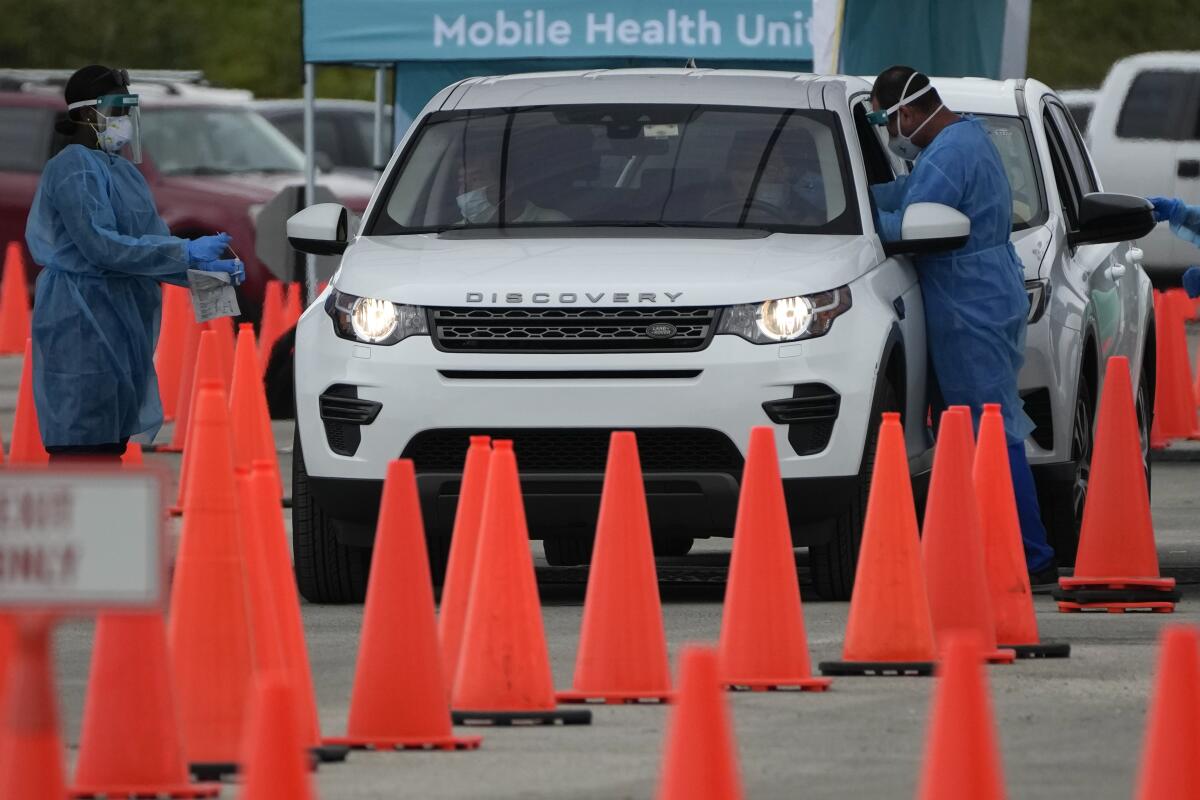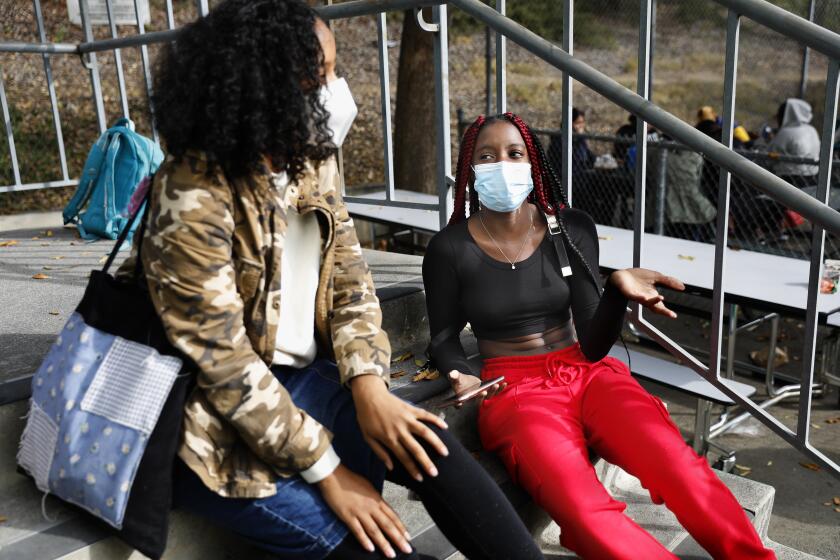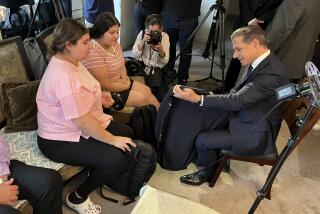Omicron upends return to U.S. schools and workplaces

- Share via
Some school systems around the U.S. extended their holiday break Monday or switched back to online instruction because of the explosion in coronavirus cases, while others pressed ahead with in-person classes amid a seemingly growing sense that Americans will have to learn to coexist with the virus.
Caught between pleas from teachers fearful of infection and parents who want their children in class, school districts in cities such as Milwaukee, New York, Detroit and beyond found themselves in a difficult position at the start of the second half of the academic year because of the super-contagious Omicron variant.
New York, home of the nation’s largest public school system, reopened classrooms to roughly 1 million students with a stock of take-home test kits and plans to double the number of random tests done in schools.
“We are going to be safe, and we will be open to educate our children,” newly sworn-in Mayor Eric Adams said on MSNBC.
New Yorker Trisha White said that she feels the risk is the same for her 9-year-old son in or out of school and that being with classmates is far better for him than remote learning.
“He could get the virus outside of school,” she said as she dropped the boy off. “So what can you do? You know, I wouldn’t blame the school system. They’re trying their best.”
While the teachers union had asked the mayor to postpone in-person learning for a week, city officials have long said that mask requirements, testing and other safety measures mean that children are safe in school. The city also has a vaccination mandate for employees.
New cases in the city shot up from a daily average of about 17,000 in the week before the holidays to nearly 37,000 last week.
What’s being done to keep kids safe as schools reopen during Omicron surge
Across the U.S., new cases have tripled in the last two weeks to more than 400,000 a day, the highest level on record, amid a rush by many Americans to get tested.
The high infection rates and resulting worker shortages are putting a heavy burden on employers large and small. Thousands of airline flights have been canceled in recent days, and many businesses have shelved return-to-work plans.
Weekend garbage collection was delayed in New Orleans, and jury trials in several Colorado counties were suspended. Some libraries on New York’s Long Island and a ski resort in New Hampshire had to close.
Dawn Crawley, chief executive of House Cleaning Heroes, a cleaning service based in Herndon, Va., said she had to cancel four of 20 cleaning jobs for Tuesday because four employees are sick — three with COVID-19.
“The fear is it will run through the team” as well as customers, she said.
Policymakers and health authorities have been mindful of the toll on the economy and the education system.
Public heath experts have said that eradicating the virus is unlikely and that the world will instead have to find a way to keep it down to an acceptable level, in much the same way it does with the flu.
Last week, after the Centers for Disease Control and Prevention cut the recommended COVID-19 isolation period from 10 days to five, CDC Director Dr. Rochelle Walensky said: “We want to make sure there is a mechanism by which we can safely continue to keep society functioning while following the science.”
In another development Monday that could have a bearing on the ability of schools to stay open, the Food and Drug Administration gave the OK for Pfizer booster shots for children as young as 12. Boosters already are recommended for everyone 16 and older.
Elsewhere in the country, the Los Angeles Unified School District announced that schools would reopen Jan. 11 because of Omicron’s rise. Furthermore, the district’s 600,000 students and roughly 73,000 employees will have to show a negative test result to enter campus. The district will have a testing site as well as take-home test kits available.
Syracuse, N.Y., canceled school Monday because of the increasing number of infections and a lack of substitute teachers.
In Wisconsin, the 75,000-student Milwaukee school system is going back to virtual instruction Tuesday because of rising cases among staff members. The district said it is aiming to return to in-person classes Jan. 10.
The FDA also said everyone 12 and older eligible for a booster can get one as early as five months after their last dose rather than six months.
The Madison, Wis., district also announced a shift to virtual learning, beginning Thursday.
Detroit School Supt. Nikolai Vitti told parents there will be no in-person or online learning through Wednesday because of a high rate of infection among employees that could lead to extensive spread of the virus and “excessive staff shortages.”
The roughly 350,000 students in the Chicago school system returned, but a dispute between district leaders and the teachers union over safety measures could disrupt classes this week. The union said it may vote Tuesday for remote teaching in the nation’s third-largest district.
The Peoria, Ill., district extended winter break by a week.
Schools in Davenport, Iowa, surprised parents early Monday by announcing the cancellation of all classes for the day because of a shortage of school bus drivers that was blamed at least in part on COVID-19.
Minnesota’s educators braced for a spike in coronavirus cases as classrooms reopened as scheduled.
“What I’ve heard from superintendents is that they are nervous about Omicron,“ said Bob Indihar, executive director of the Minnesota Rural Education Assn. “It seems to be the new normal that changes are going to happen and quarantines and people being out are just part of the process now. Districts are kind of taking it in stride.”
The president of the National Parents Union, a network of parent organizations, called the sudden switch back to virtual learning “an abomination.”
“Once again, parents are left scrambling at the last minute and, worse, far too many children are being deprived of an in-person learning experience, which is critical for their academic and social-emotional development,” Keri Rodrigues said in a statement.
Peltz reported from New York. Ehlke reported from Milwaukee. Tang reported from San Jose. Associated Press writers Margery Beck in Omaha; Anne D’Innocenzio in New York; Michael Hill in Albany, N.Y.; Kevin McGill in New Orleans; Rick Callahan in Indianapolis; Sophia Tareen in Chicago; Jennifer Sinco Kelleher in Honolulu; and Corey Williams in Detroit contributed to this report.
More to Read
Sign up for Essential California
The most important California stories and recommendations in your inbox every morning.
You may occasionally receive promotional content from the Los Angeles Times.












